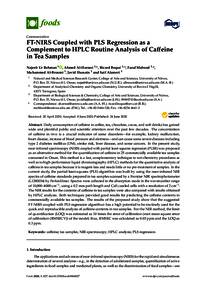Document
FT-NIRS coupled with PLS regression as a complement to HPLC routine analysis of Ca eine in tea samples.
Identifier
DOI: 10.3390/foods9060827
Source
Foods. v. 9 (6), 827 [1-11].
Contributors
Al-Harrasi, Ahmed., Author
Boqué, Ricard., Author
Mabood, Fazal., Author
Al-Broumi, Muhammed., Author
Hussain, Javid., Author
Al-Ameri, Saif., Author
Country
Switzerland
Publisher
MDPI AG.
Gregorian
2020-06-01
Language
English
Subject
English abstract
Daily consumption of caffeine in coffee, tea, chocolate, cocoa, and soft drinks has gained wide and plentiful public and scientific attention over the past few decades. The concentration of caffeine in vivo is a crucial indicator of some disorders for example, kidney malfunction, heart disease, increase of blood pressure and alertness and can cause some severe diseases including type 2 diabetes mellitus (DM), stroke risk, liver disease, and some cancers. In the present study, near-infrared spectroscopy (NIRS) coupled with partial least-squares regression (PLSR) was proposed as an alternative method for the quantification of caffeine in 25 commercially available tea samples consumed in Oman. This method is a fast, complementary technique to wet chemistry procedures as well as to high-performance liquid chromatography (HPLC) methods for the quantitative analysis of caffeine in tea samples because it is reagent-less and needs little or no pre-treatment of samples. In the current study, the partial least-squares (PLS) algorithm was built by using the near-infrared NIR spectra of caffeine standards prepared in tea samples scanned by a Frontier NIR spectrophotometer (L1280034) by PerkinElmer. Spectra were collected in the absorption mode in the wavenumber range of 10,000 4000 cm-1, using a 0.2 mm path length and CaF2 sealed cells with a resolution of 2 cm-1. The NIR results for the contents of caffeine in tea samples were also compared with results obtained by HPLC analysis. Both techniques provided good results for predicting the caffeine contents in commercially available tea samples. The results of the proposed study show that the suggested FT-NIRS coupled with PLS regression algorithun has a high potential to be routinely used for the quick and reproducible analysis of caffeine contents in tea samples. For the NIR method, the limit of quantification (LOQ) was estimated as 10 times the error of calibration (root mean square error of calibration (RMSECV)) of the model; thus, RMSEC was calculated as 0.03 ppm and the LOQ as 0.3 ppm.
ISSN
2304-8158
Resource URL
Category
Journal articles

